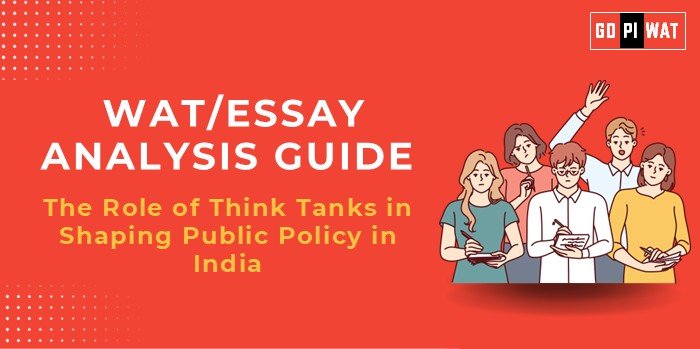📋 Written Ability Test (WAT) / Essay Analysis Guide
🌐 The Role of Think Tanks in Shaping Public Policy in India
🧠 Understanding the Topic’s Importance
Think tanks serve as bridges between academic research and practical policy implementation, offering evidence-based recommendations that inform government decisions and public discourse.
🕒 Effective Planning and Writing
- Time Allocation:
- Planning: 5 minutes
- Writing: 20 minutes
- Review: 5 minutes
- Preparation Tips:
- Identify key contributions of Indian think tanks to major policy initiatives.
- Gather data on the number and global rankings of Indian think tanks.
✍️ Introduction Techniques
1. Contrast Approach
“Despite hosting over 600 think tanks, India’s policy landscape often underutilizes their potential compared to countries like the US.”
2. Solution-Based Approach
“Empowering think tanks through diversified funding and regulatory support can significantly enhance their role in India’s policy development.”
📚 Structuring the Essay Body
Achievements
- Significant Role: Think tanks in India have influenced public policy across diverse domains.
- Examples:
- NITI Aayog: Spearheaded initiatives like the Atal Innovation Mission to foster entrepreneurship.
- Centre for Policy Research (CPR): Provided vital inputs on governance reforms.
- Observer Research Foundation (ORF): Enhanced India’s global diplomatic standing through platforms like the Raisina Dialogue.
Challenges with Comparative Analysis
- Funding Dependence: Heavy reliance on government grants or private donors raises concerns about bias and autonomy.
- Regulatory Constraints: Compliance with the Foreign Contribution Regulation Act (FCRA) restricts access to international funding.
- Global Comparison: US think tanks like the Brookings Institution operate with greater independence.
- Urban Bias: Many think tanks focus primarily on urban issues, neglecting rural and marginalized communities.
Future Outlook
- Diversified Funding: Leverage corporate social responsibility (CSR) initiatives to enhance autonomy.
- Regional Outreach: Establish think tank hubs in rural and semi-urban areas to address grassroots issues.
- Global Inspiration: Learn from Estonia’s emphasis on e-governance and China’s state-supported frameworks.
- Collaboration: Partner with academia and international organizations to amplify influence and inclusivity.
📜 Concluding Effectively
Balanced Perspective Conclusion
“Think tanks in India are invaluable in shaping evidence-based public policy, yet their potential remains underutilized due to challenges like funding constraints and regulatory hurdles. By addressing these issues and learning from global best practices, India can empower its think tank ecosystem to drive more inclusive and impactful policy innovation.”
Global Comparison Conclusion
“The experiences of countries like the United States and China demonstrate the potential of think tanks to significantly influence public policy. By leveraging international insights and fostering domestic reforms, India can position its think tanks as key players in global and local policy landscapes.”
🔧 Recommendations for Sustainable Progress
- Diversify funding mechanisms, including CSR partnerships and philanthropic contributions, to ensure autonomy.
- Establish think tank hubs in rural and semi-urban areas to promote regional representation.
- Enhance collaboration between think tanks, government agencies, and international organizations to address complex, multi-sectoral challenges.
💡 Sample Short Essays
1. Balanced Perspective (100 words)
“Indian think tanks have emerged as vital contributors to public policy, offering research-driven insights and fostering informed debates. However, challenges such as funding constraints and urban bias limit their full potential. Addressing these issues requires diversifying financial sources and promoting regional think tanks to include grassroots perspectives. Drawing inspiration from the independent operations of US think tanks and the strategic focus of China’s policy research ecosystem, India can empower its think tanks to become catalysts for more inclusive and impactful governance.”
2. Solution-Oriented (100 words)
“To maximize the impact of think tanks on public policy, India must prioritize funding autonomy and operational inclusivity. Initiatives like CSR funding and regional think tank hubs can ensure greater representation and reduce urban bias. Collaborations with global institutions and academia can further enhance their analytical capacity. With these reforms, think tanks can better serve as bridges between research and action, shaping policies that address the nation’s diverse challenges and opportunities.”
3. Global Comparison (100 words)
“India’s think tanks operate in a dynamic yet challenging landscape, contrasting with the independence of US institutions and the centralized frameworks of China. By adopting elements from these global models, such as the Brookings Institution’s financial independence and China’s strategic policy alignment, Indian think tanks can achieve greater effectiveness. Strengthening autonomy, fostering regional outreach, and encouraging international collaborations will not only enhance their domestic impact but also position them as key contributors in the global policy ecosystem.”


